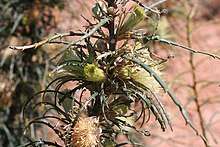Banksia strictifolia
Banksia strictifolia is a species of bushy shrub that is endemic to Western Australia. It has serrated, linear leaves with sharply-pointed teeth on both sides, creamy yellow flowers in heads of between forty-five and eighty-five, and egg-shaped to more or less spherical follicles.
| Banksia strictifolia | |
|---|---|
 | |
| Near Hill River | |
| Scientific classification | |
| Kingdom: | Plantae |
| Clade: | Tracheophytes |
| Clade: | Angiosperms |
| Clade: | Eudicots |
| Order: | Proteales |
| Family: | Proteaceae |
| Genus: | Banksia |
| Subgenus: | Banksia subg. Banksia |
| Series: | Banksia ser. Dryandra |
| Species: | B. strictifolia |
| Binomial name | |
| Banksia strictifolia | |
| Synonyms[1] | |
|
Dryandra stricta A.S.George | |
Description
Banksia strictifolia is a bushy shrub that typically grows to a height of 3 m (9.8 ft) but does not form a lignotuber. It has glabrous stems and linear leaves 50–200 mm (2.0–7.9 in) long and 4–9 mm (0.16–0.35 in) wide on a petiole up to 5 mm (0.20 in) long. There are between eight and eighteen sharply-pointed, triangular teeth on each side of the leaves. The flowers are borne in heads of between 45 and 85 with lance-shaped to narrow triangular, hairy involucral bracts up to 13 mm (0.51 in) long at the base of the head. The flowers are creamy yellow and have a perianth 23–35 mm (0.91–1.38 in) long and a straight pistil 23–25 mm (0.91–0.98 in) long. Flowering occurs from August to October and the fruit is a sparsely hairy, egg-shaped to more or less spherical follicle 6–8 mm (0.24–0.31 in) long.[2][3][4]
Taxonomy and naming
This banksia was first formally described in 1996 by Alex George in the journal Nuytsia and given the name Dryandra stricta from specimens he collected near the Brand Highway near Regans Ford in 1986.[2][5] In 2007, Austin Mast and Kevin Thiele transferred all the dryandras to the genus Banksia but since the name Banksia stricta had already been used for a species now known as Pimelea stricta,[6] Mast and Thiele changed the name to Banksia strictifolia.[7][8] The specific epithet (strictifolia) is from the Latin strictus meaning "straight" and -folius meaning "leaved".[9]
Distribution and habitat
Banksia strictifolia grows in kwongan between Three Springs and Badgingarra.
Conservation status
This banksia is listed as "not threatened" by the Western Australian Government Department of Parks and Wildlife.[4]
References
- "Banksia strictifolia". Australian Plant Census. Retrieved 6 June 2020.
- George, Alex S. (1996). "New taxa and a new infrageneric classification in Dryandra R.Br". Nuytsia. 10 (3): 338–339.
- George, Alex S. (1999). Flora of Australia (PDF). 17B. Canberra: Australian Biological Resources Study, Canberra. p. 227. Retrieved 6 June 2020.
- "Banksia strictifolia". FloraBase. Western Australian Government Department of Parks and Wildlife.
- "Dryandra stricta". APNI. Retrieved 6 June 2020.
- "Pimelea stricta". Australian Plant Census. Retrieved 6 June 2020.
- "Banksia strictifolia". APNI. Retrieved 6 June 2020.
- Mast, Austin R.; Thiele, Kevin (2013). "The transfer of Dryandra R.Br. to Banksia L.f. (Proteaceae)". Australian Systematic Botany. 20 (1): 63–71. doi:10.1071/SB06016.
- Francis Aubie Sharr (2019). Western Australian Plant Names and their Meanings. Kardinya, Western Australia: Four Gables Press. p. 315. ISBN 9780958034180.
- Cavanagh, Tony; Pieroni, Margaret (2006). The Dryandras. Melbourne: Australian Plants Society (SGAP Victoria); Perth: Wildflower Society of Western Australia. ISBN 1-876473-54-1.